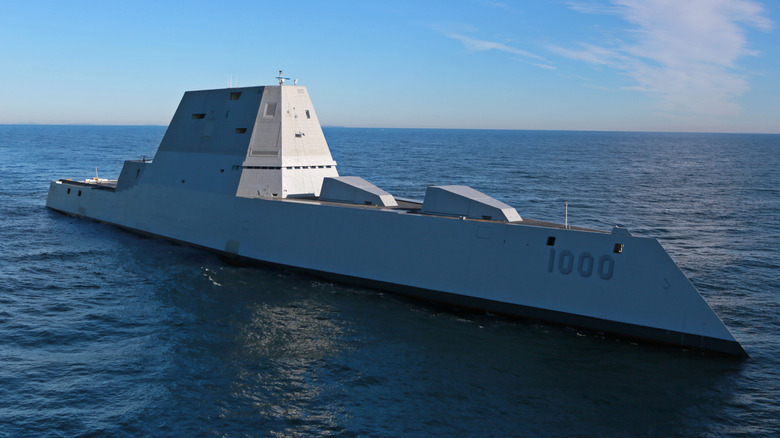Why Is The USS Zumwalt Shaped Differently From Other Ships?
The USS Zumwalt, officially designated DDG-1000, is the first of the U.S. Navy's Zumwalt class of guided missile destroyers. The ship stands as a pinnacle of naval innovation and is widely regarded as the most advanced naval vessel ever built. It is named in tribute to Admiral Elmo Zumwalt, who, at 49, became the youngest U.S. Chief of Naval Operations and is one of the leading figures credited with significantly transforming and modernizing the U.S. Navy.
A defining characteristic of the USS Zumwalt is undoubtedly its distinctive, angular tumblehome hull, a radical departure from contemporary naval vessels. Interestingly, this distinctive wave-piercing design isn't new; similar profiles were common on wooden warships centuries ago. The U.S. Navy chose to revive and adapt the design, primarily due to the significant stealth advantages it offers.
The tumblehome hull boasts an inward-sloping design that narrows considerably above the waterline. This allows the bow to cut through waves, rather than riding over them, potentially allowing for a smoother ride in rough seas. More importantly, this design significantly reduces the radar cross-section of the vessel, allowing it to appear smaller than it is. The USS Zumwalt, at 185.9 meters (610 feet) and 15,997 tons, is 40% larger than an Arleigh Burke destroyer, yet its radar cross-section is reportedly the size of a small fishing boat.
This hull design is complemented by a composite deckhouse structure, and a revolutionary electrical propulsion system. These elements all combine to make the USS Zumwalt considerably harder to detect in the open seas, reducing the threat of an attack.
A rough ride for the Zumwalt-class destroyers
The USS Zumwalt is joined in its class by the USS Michael Monsoor (DDG-1001), delivered to the U.S. Navy in April 2018 and commissioned in January 2019. Then there is the USS Lyndon B. Johnson (DDG-1002), currently receiving a modernization to its weapons systems at Huntington Ingalls Industries' Pascagoula Shipyard in Mississippi. All three ships sport a similar design. However, the deckhouse of the USS Lyndon B. Johnson is made of steel instead of composite materials to save costs.
It has not been a smooth journey for the Zumwalt-class destroyers. The project faced several criticisms due to multiple delays, performance issues, and cost overruns. The challenges reportedly forced the U.S. Navy to scale back its initial demand from 32 Zumwalt-class destroyers to just three, with each unit eventually costing about $8 billion.
The Zumwalt-class destroyers were initially conceived as multi-mission stealth ships with a focus on land attacks and close-to-shore mission support. However, fulfilling these types of missions in the real world would render the ship's stealth capabilities somewhat redundant since enemy forces, equipped with high-powered binoculars, could simply pick out the ship on the horizon.
To worsen matters, the USS Zumwalt and its sister ships were built around two 155 mm Advanced Gun Systems that never became fully operational. The guns were ultimately rendered unusable due to the cancellation of their specialized ammunition, the Long-Range Land Attack Projectile (LRLAP). Reducing the Zumwalt-class order from 32 to three pushed the cost per LRLAP round to more than $800,000, an expense the U.S. Navy could not justify.
Keeping the USS Zumwalt relevant
The performance challenges posed by the USS Zumwalt forced the U.S. Navy back to the drawing board. To keep the Zumwalt relevant and leverage its stealth and other advantages, a decision was made to replace the 155 mm main guns with missile tubes.
Dubbed the Conventional Prompt Strike system, this U.S. Navy program aims to equip the three Zumwalt-class destroyers and Virginia-class submarines with a hypersonic missile launch system. The successful integration of this system would represent a significant leap in naval offensive capabilities, transforming the Zumwalt into a formidable naval platform.
The USS Zumwalt is already undergoing this weapons system modernization. Upon completion, the ship will carry four advanced payload modules, each capable of carrying three hypersonic missiles. This conversion will make the USS Zumwalt the first U.S. Navy ship with the capacity to launch hypersonic missiles. The remaining destroyers in the Zumwalt-class are also in line to receive the Conventional Prompt Strike system upgrade.
Retrofitting the Zumwalt-class destroyers with hypersonic missile capabilities transforms them into cutting-edge naval assets. It may finally put these unique vessels onto a stage where the U.S. Navy can fully exploit its impressive capabilities.


